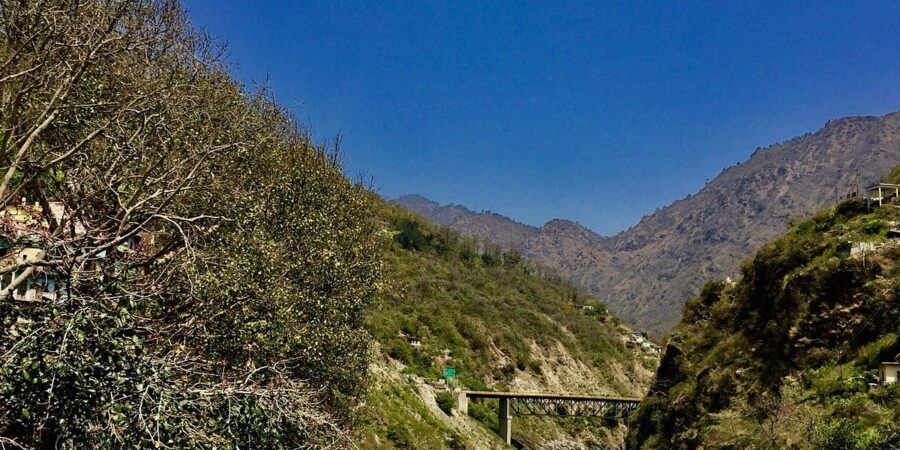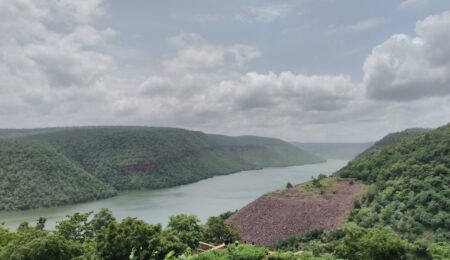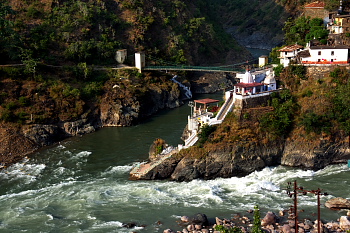 Flowing through the majestic landscapes of Uttarakhand in northern India, the Alaknanda River is a holy waterway with immense spiritual significance. Originating from the pristine glaciers of the Satopanth and Bhagirathi Kharak glaciers in the Garhwal Himalayas, this divine river carves its way through valleys, gorges, and picturesque towns, enchanting pilgrims and nature lovers alike. With its mesmerizing beauty and spiritual aura, the Alaknanda River has captivated the hearts and souls of people for centuries.
Flowing through the majestic landscapes of Uttarakhand in northern India, the Alaknanda River is a holy waterway with immense spiritual significance. Originating from the pristine glaciers of the Satopanth and Bhagirathi Kharak glaciers in the Garhwal Himalayas, this divine river carves its way through valleys, gorges, and picturesque towns, enchanting pilgrims and nature lovers alike. With its mesmerizing beauty and spiritual aura, the Alaknanda River has captivated the hearts and souls of people for centuries.
The Alaknanda River is considered one of the two headstreams of the sacred Ganga River, the other being the Bhagirathi River. The confluence of these two rivers at Devprayag marks the beginning of the Ganga, a river revered by millions across the nation. As the Alaknanda River descends from its glacial origin, it gathers momentum and flows through the revered pilgrimage sites of Badrinath, Joshimath, and Rudraprayag, blessing the land with its divine presence.
The origin of the Alaknanda is traditionally placed at the confluence of the Bhagirathi and the Mandakini rivers, which both rise from glaciers in the Garhwal Himalaya. The Bhagirathi is considered the main source stream of the Ganges, though its length is only about 230 kilometres (143 mi) long. The headwaters of the Alaknanda are formed by the confluence of two streams, the Vishnuganga and the Dhauliganga, at Devprayag in Uttarakhand. The Vishnu-Ganga is longer, at about 320 kilometres (199 mi), but it joins the Alaknanda at a lower elevation, about 1,000 metres (3,281 ft) below that of the Dhauliganga. The Alaknanda then continues southeast through the mountains for about 240 kilometres (149 mi) before joining the Ganges.
In Hindu mythology, the Alaknanda River is believed to be a celestial manifestation of the goddess Ganga. Legend has it that Lord Vishnu, in his incarnation as Vamana, took a holy bath in the river, and his footprints can still be seen at the sacred site of Hemkund Sahib. The river is mentioned in ancient texts like the Mahabharata and the Puranas, adding to its sacred status and significance.
The Alaknanda is considered the most sacred of all the rivers in India. Hindus believe bathing in the river will cleanse them of their sins and purify their souls. The river is also believed to be the abode of the goddess Ganga.
Pilgrimage along the Alaknanda River is a profound journey of devotion and self-discovery. The holy town of Badrinath, nestled on the banks of the river, is a major pilgrimage destination. It is believed to be the abode of Lord Vishnu in his form as Lord Badrinarayan. Pilgrims undertake arduous treks to reach Badrinath, seeking blessings and immersing themselves in the divine atmosphere. The riverbanks of the Alaknanda witness the confluence of countless devotees, who come to cleanse their sins and offer prayers to attain spiritual liberation.
The Alaknanda is formed at the confluence of the Satopanth and Bhagirath Kharak glaciers in the Uttarakhand Himalayas. The Bhagirath Kharak glacier is named after Bhagiratha, a legendary king who is said to have brought the Ganga down from heaven. The Alaknanda flows south from the Himalayas, through the Alaknanda valley, and joins the Bhagirathi at Devprayag. The Alaknanda is one of the main rivers of the Uttarakhand Himalayas and is an important tributary of the Ganga. The river has great religious significance in Hinduism. Several Hindu scriptures mention the river, including the Mahabharata and the Puranas.
The Alaknanda is also one of the main rivers of the Uttar Pradesh Himalayas and is an important tributary of the Ganga. The river has great religious significance in Hinduism. Several Hindu scriptures mention the river, including the Mahabharata and the Puranas. The Alaknanda is a glacier-fed river, and its main tributaries are the Mandakini, the Nandakini, and the Pindar. The Alaknanda valley has several glaciers, including the Satopanth and the Bhagirath Kharak. The Alaknanda river basin is also home to several important Hindu pilgrimage sites, such as Badrinath, Kedarnath, and Gangotri.
 The Alaknanda River is a spiritual abode and a sanctuary of natural beauty. Surrounded by snow-capped peaks, dense forests, and serene meadows, the river creates an idyllic setting that mesmerizes visitors. The Valley of Flowers National Park, a UNESCO World Heritage Site near the Alaknanda River, showcases a breathtaking array of alpine flowers, making it a paradise for nature enthusiasts. The tranquil ambience, the gushing sound of the river, and the awe-inspiring vistas create an environment of peace and serenity.
The Alaknanda River is a spiritual abode and a sanctuary of natural beauty. Surrounded by snow-capped peaks, dense forests, and serene meadows, the river creates an idyllic setting that mesmerizes visitors. The Valley of Flowers National Park, a UNESCO World Heritage Site near the Alaknanda River, showcases a breathtaking array of alpine flowers, making it a paradise for nature enthusiasts. The tranquil ambience, the gushing sound of the river, and the awe-inspiring vistas create an environment of peace and serenity.
The Alaknanda River also plays a vital role in the region’s ecology and economy. The river’s water supports local agriculture, providing irrigation for wheat, rice, and potatoes. The fertile soil along its banks enables the cultivation of various agricultural produce. Furthermore, the river’s water resources have been harnessed for hydroelectric power generation, contributing to the region’s energy needs.
However, the Alaknanda River faces environmental challenges, including erosion, landslides, and the impact of climate change. Deforestation, pollution, and unsustainable tourism practices also threaten the river’s delicate ecosystem. It is crucial to implement sustainable measures and raise awareness to preserve the river’s pristine beauty and ecological balance.
Visiting the Alaknanda River is an immersive experience that connects profoundly with nature and spirituality. The cool breeze, the refreshing touch of the river’s waters, and the mystical ambience create a sense of tranquillity and harmony. Pilgrims and travellers can witness the timeless flow of devotion and feel the divine energy that emanates from the river and its surroundings.
In conclusion, the Alaknanda River is more than a geographical feature; it is a sacred pathway that intertwines spirituality, natural beauty, and cultural heritage. It represents the eternal flow of devotion and the profound connection between human beings and nature. As we cherish and protect the sanctity of the Alaknanda River, let us do so with a deep sense of reverence, gratitude, and responsibility, ensuring that its pristine beauty and spiritual significance are preserved for generations to come.




